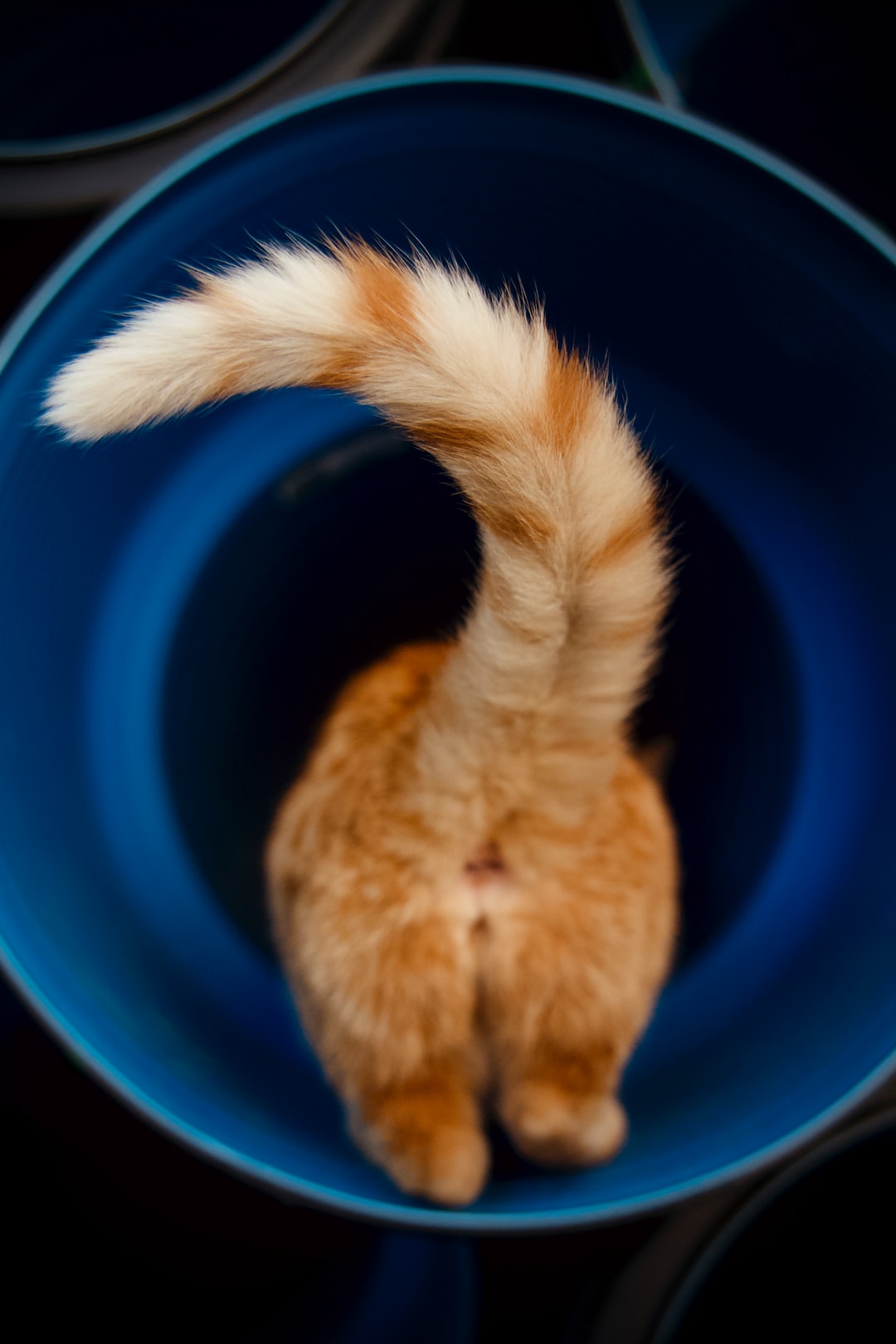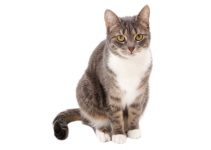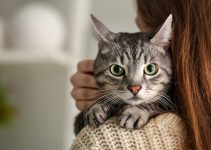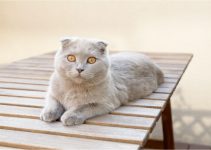Have you been wondering why do cat’s tails puff up? Well, wonder no longer!
We’re here to tell you the answer to that question. There are a few reasons why cats might puff their tails up, and we’ll discuss them all in this blog post.
So keep reading to learn more about your kitty’s behavior and what it might mean.
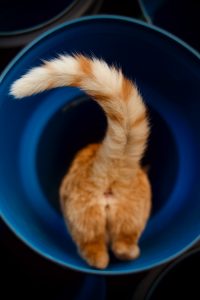
Contents
The Cat Tail Puff is Feline Body Language
Regular readers may know, we wrote another article about feline body language called “Top 13 Warning Signs When Introducing Cats.”
Cats may not speak our language, but they communicate with their humans in their special ways. Cats’ tails are sometimes their most effective method of communication. That’s because they play such an essential role in their lives. A cat uses their tail to balance, to hunt prey, and to tell others how they’re feeling.
The Hunting Instinct
Did you know that a cat’s tail plays an essential role in its hunting instinct? A cat’s ancestors relied on the ability to hunt and catch prey for survival.
While today, we feed our cats meals in bowls, they still retain some of their wild instincts from before domestication. That includes their need to stalk and pounce during playtime!
When a cat’s tail is puffed up and held high, it can indicate happiness, aggression, or playfulness. When they are stalking something during playtime or hunting down prey in the wild (or even while chasing a toy mouse), they will hold their tails vertically and straighten them out to keep balance as they jump. They might also wag it back and forth to show excitement or agitation.
Since cats are predators, they can become aggressive when hunting, defending territory, and mating.
Territory Marking
Many cats are spayed or neutered when they are young, but most still retain their territorial instincts. That’s why it’s essential to keep multiple cats in the same home separate as much as possible during feeding times and playtime.
Though there is less of a chance of getting into a fight or losing an eye over food if your cat is spayed or neutered, they may still mark their territory in other ways.
One way they do this is by spraying urine, which has a strong odor that lets other cats know this spot belongs to them. Another way they can mark their territory is by rubbing their cheeks against objects or people, leaving behind traces of scent from glands near their eyes.
When a cat is in a calm or happy state, it will hold its tail vertical but with a slight curve at the tip.
If you see your kitty holding her tail high and puffed up, it could mean one of two things: she’s either scared or excited. However, cats often use this stance to show aggression too.
A cat with a fluffy tail may be feeling territorial.
Fear and Anxiety
A cat expresses fear and anxiety differently than other emotions. When a cat is scared, it will tuck its tail between its legs and crouch low to the ground in an attempt to make itself appear smaller.
This stance may be seen when another animal or person enters their territory unexpectedly or if they are trying to avoid confrontation with another pet in the household.
Cats may also exhibit signs of fear and anxiety when they are in new or unknown environments. This can manifest as hiding, fleeing, or attacking.
If your cat’s tail is puffed up and it’s not in a playful mood, it’s probably best to give them some space until they calm down. Sometimes cats fluff up their tails to make themselves appear bigger.
This is the opposite stance to the shrinking stance we just described. However, it can be triggered by the same stimuli.
A cat that is afraid will try to make itself appear larger by puffing out its fur and holding its tail high, as if it’s saying, “Don’t mess with me!” This usually happens when a threat comes into the territory or home unexpectedly.
For example, your cat may fluff up their tail when you come home from work and smell like other human beings. You may also notice this behavior when a stranger comes to the door.
It’s important to remember that cats are individuals and will not always exhibit the same behavior in every situation. If you’re ever unsure of what your cat’s tail is telling you, it’s best to observe their body language overall and what is in their line of sight.
Playtime
Would your cat fluff up their tail just to be playful? You bet!
Many cats will hold their tails high and puff them out when they’re feeling frisky. This is a sign that they are ready to play and may even be inviting you to join in on the fun.
When a cat is playful, it might also wag its tail back and forth or move it from side to side.
If your cat is in a playful mood, it’s probably best to indulge them! A game of catch with a soft toy or chase can help wear them out and make them less likely to get into trouble later on.
Stress Relief
We all get stressed out from time to time and so do our feline friends.
Just like people, cats may seek out ways to relieve their stress. One way they do this is by grooming themselves excessively.
Another way a cat can deal with stress is by puffing up its fur. This makes them look bigger and more intimidating, which may scare away whatever or whoever is causing them distress.
Cats may also vocalize more when they’re stressed, either by meowing loudly or yowling.
If you see your cat is puffing up their tail and seems to be under a lot of stress, it might be best to try and calm them down. You can do this by providing them with a safe place to hide, like a cat tree in your bedroom, or giving them extra attention with pets and cuddles.
Even a cardboard box can be a great place for a cat to hide if it’s feeling stressed out.
Nervousness or Restlessness
Some cats may puff up their fur and tail when they’re feeling nervous or restless.
This may be a sign that your cat is about to do something destructive, like scratching the furniture or attacking other pets in the household.
While it’s not always possible to tell what a cat is thinking, you can try to distract them with toys and treats. A cat who is usually allowed to go outdoors but is cooped up indoors on vets orders or because of danger in the yard might fluff their tail in frustration.
If you have a restless, or frustrated cat, you should keep them busy with toys and playtime. This will help burn off their excess energy and make them less likely to act out in destructive ways.
Getting Attention
Surprising though it may seem, cats can puff up their tails to get your attention.
Instead of meowing or tapping you with a paw, some cats will fluff up their tail and hold it high as if they’re saying “Look at me!”
The cat may also wag its tail from side to side or move it back and forth. This is another sign that your cat is feeling playful and wants you to join in on the fun with them.
Sometimes, cats will puff up their tails when they want something from you, like food or attention. Although cats rarely like to be trained as much as dogs, if you do routinely reward a cat with treats, it will figure out what it needs to do to get them.
It’s Itchy and Molting
This final entry in our list of reasons why cats puff their tails is an unusual one. How often do you brush your cat’s tail to free the loose fur that has molted?
Long-haired cats shed a lot of furs. A spot they often neglect to clean is their tail. It’s one of a cat’s more tricky body parts to access. Sometimes a cat’s tail becomes overburdened with loose fur.
It possibly feels better when it is shaken and fluffed up for your kitty.
Try putting an old sock on your hand and then run it gently along the length of your cat’s tail. If a lot of loose furs come away, chances are that your cat’s tail was molting. By brushing his or her tail with a pet brush, or an old sock you can soon de-fluff your cat’s principal communication device.
Did We Answer Why Do Cat’s Tails Puff Up?
We hope that this article has helped you answer the question, “Why do cat’s tails puff up?”
If your cat is doing it for one of the reasons we’ve listed above, there’s probably nothing to worry about.
However, if you’re concerned about why your kitty is puffing its tail up and are worried that it might be a sign of something more serious, please consult your veterinarian.
If you enjoyed this article you might like reading our article about what cats enjoy eating for breakfast.
